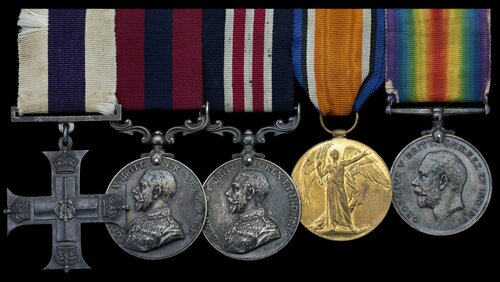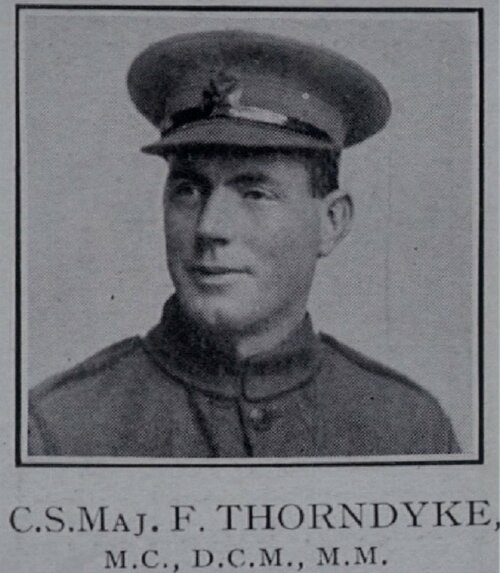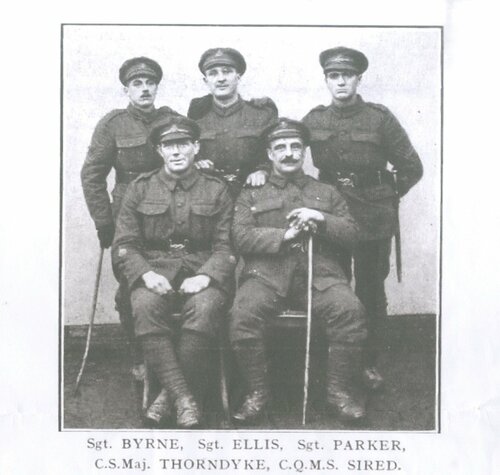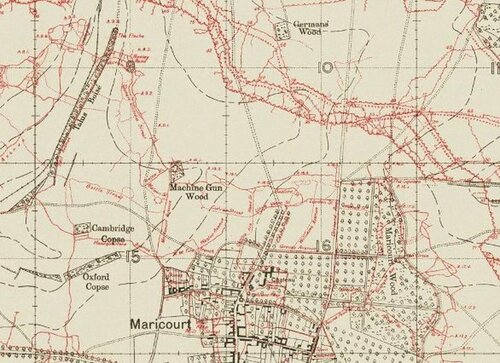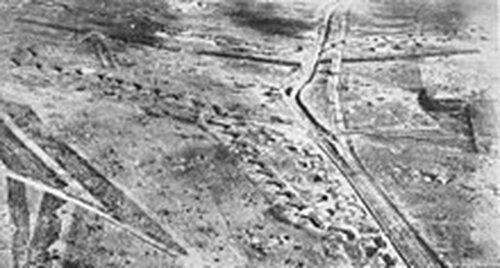Auction: 21103 - Orders, Decorations and Medals e-Auction 4
Lot: 329
The superb and unique Great War M.C., D.C.M., M.M. group of five awarded to Company Sergeant Major F. Thorndyke, 2/6 (City of London) Battalion, London Regiment, who won all three awards in just two years until being wounded whilst gallantly leading his company to attack three German machine-gun posts at the Battle of Amiens
Military Cross, G.V.R., unnamed as issued; Distinguished Conduct Medal, G.V.R. (320660 Sjt. F. H. Thorndyke. 2/6 Lond: R); Military Medal, G.V.R. (320660 C. S. Sjt F. H. Thorndyke. D.C.M. 6/ Lond: R.); British War and Victory Medals (2388 W.O.Cl.2. F. H. Thorndyke. 6-Lond. R.), mounted as worn, minor wear and slight edge bruise to second, overall good very fine (5)
A unique combination of Gallantry and Campaign awards to Other Ranks for the Great War.
M.C. London Gazette 30 July 1919:
'Near Maricourt, south-east of Albert, during the operations of August 27th/28th, 1918, this warrant officer commanded a company in the attack with great skill and gallantry, all the officers having become casualties. With two other men he captured two enemy machine guns with their teams and was wounded endeavouring to capture a third. Throughout the operations on the 27th and 28th he showed conspicuous courage and qualities of leadership.'
D.C.M. London Gazette 19 November 1917:
'For conspicuous gallantry and devotion to duty in action. He took over command of his company after his commander had been wounded and led them brilliantly to the attack, driving the enemy out of their front line trenches, which he held until his ammunition was expended and all other units had been obliged to retire, when he withdrew in good order to his original position.'
M.M. London Gazette 24 January 1919.
Frederick Henry Thorndyke was born on 22 July 1886 at Colchester, Essex, the son of Walter and Sarah Thorndyke. Living at 74 Chilton Street, Rotherhithe. In his early years Thorndyke began work as a Junior Clerk on 31 March 1901 before moving into a more senior role as Clerk at a Tar Works on 2 April 1911. On the outbreak of war he was served with 2/6th (City of London) Battalion, London Regiment and seeing home service for the early years of the war with 2/1st London Division, later renamed the 58th Division. Thorndyke joined the war on 25 January 1917 with the rank of Sergeant, landing with 2/6th Battalion at La Havre.
They joined the action early at Bullecourt towards the tail end of the Battle of Arras, the village had been under continuous attack for six weeks and by the time of their arrival had finally fallen to the allies. As a result the 2/6th were ordered to follow-up on this success by advancing beyond Bullecourt and capturing Bovis Trench. Advancing in conjunction with a creeping barrage the still comparatively inexperienced attackers did not recognise the shelled out trench as their objective and pushed beyond it into the teeth of the German defences. An attempt to dig in failed and soon they were forced back with gaps opening in the line which the enemy exploited, returning to their start line the Battalion was found to have lost almost half its Officers and Other Ranks. Fortunately, Throndyke survived his Battalion's baptism of fire.
The losses suffered at Bullecourt necessitated a period of recuperation however the Battalion did see action again that year at Menin Ridge Road, most notably during the attack on St. Julian. The next year they were amalgamated with the 1/6th Battalion to form 6th Battalion, London Regiment in February 1917. In at the action again during the Battle of Villers-Bretonneux, part of the German Spring Offensive, the fighting was so confused that 6th Battalion became separated from the 58th Division and briefly came under French Command. They also suffered heavily from a surprise gas attack on the night of 16/17 April while bedding down in the open outside Amiens. By the time of the Battle of Amiens in August 1918 Thorndyke had been promoted Company Sergeant Major as a compliment to the D.C.M. he had been awarded the year before. The 6th Battalion went into action on 8 August, taking part in attacks on Marland Wood and Chipilly Ridge, both actions were notably confused but unlike their experiences at the Battle of Arras the 6th carried their objectives in good order. Despite losses of over 300 men in the opening of the offensive they went into battle again on 26 August at Maricourt during which Thorndyke demonstrated his leadership and bravery. Taking command of his company he led them against the defences and captured three enemy machine gun positions, being wounded in the approach to the last one.
Upon leaving the army on 30 August 1919 he returned home to sad news, his father had passed away in June of that year. Despite this Thorndyke forged ahead, marrying Ivy Caroline Purbrick on 10 November 1919 at St. Barnabas Church, Rotherhithe. The couple moved to America that same year, joining Ivy's Mother and Stepfather in Newark, New Jersey before returning to Britain in 1921. The remainder of Thorndyke's life would be spent in a similar pattern, spending years in New York and years in Rotherhithe with his occupation listed variously as shopkeeper and salesman. With the outbreak of the Second World War the family settled in Ilford, Essex and it was here that Thorndyke died at 67 Courtland Avenue on 16 April 1943; sold together with London Gazette citations, M.I.C. citations and copied photographs of the recipient.
For his miniature medals see Lot 354.
Subject to 20% VAT on Buyer’s Premium. For more information please view Terms and Conditions for Buyers.
Sold for
£20,000
Starting price
£6800

